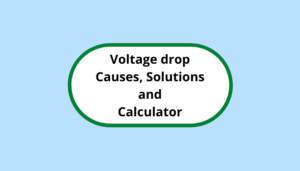If you’re working with electrical systems, you may need to calculate the total power in a 3 phase system.
The power in a 3 phase system is important because it tells you how much energy is being consumed, and it can help you determine the size of the circuit breakers and conductors needed to support the system.
In this article, we’ll go through the steps to calculate the total power in a 3-phase system.
Table of Contents
What is a 3-Phase System?
Before we dive into the calculations, let’s review what a 3 phase system is. A 3-phase system is a type of electrical power transmission that uses three alternating currents that are out of phase with each other.
This creates a more efficient power transmission system compared to a single-phase system. In a 3 phase system, there are three “hot” wires that are used to distribute power and a neutral wire that is used for grounding.
Calculating Total Power in a 3-Phase System
To calculate the total power in a 3 phase system, you will need to know the voltage and current of each of the three phases. The formula for calculating total power in a 3-phase system is:
Total Power = √3 x Voltage x Current x Power Factor
Let’s break down this formula into its components.
Voltage: The voltage is the amount of electrical potential energy that is present in each phase of the system. In the formula, we use the line-to-line voltage, which is the voltage between any two of the three phases.
Current: The current is the amount of electrical charge that is flowing through each phase of the system. In the formula, we use the average current, which is the total current divided by three.
Power Factor: The power factor is a measure of how efficiently the power is being used in the system. It ranges from 0 to 1, with 1 being the most efficient. A power factor of less than 1 means that some of the power is being lost as heat or other forms of energy.
Once you have the voltage, current, and power factor for each phase, you can plug them into the formula to calculate the total power.
Here’s an example:
Suppose you have a 3-phase system with a line-to-line voltage of 480 volts, an average current of 100 amps, and a power factor of 0.8. To calculate the total power, you would use the formula:
Total Power = √3 x Voltage x Current x Power Factor Total Power = √3 x 480 volts x 100 amps x 0.8 Total Power = 83,138 watts or 83.1 kilowatts
In this example, the total power of the 3-phase system is 83.1 kilowatts.
calculating the current in a 3-phase system
The formula for calculating the current in a 3-phase system depends on the load the system is powered by.
For a balanced 3-phase load, where all three phases have the same impedance, the formula for calculating the current is:
Current = Power / (√3 x Voltage x Power Factor)
Where:
- Power is the amount of power consumed by the load in watts
- Voltage is the line-to-line voltage of the 3-phase system in volts
- Power Factor is the ratio of the real power (in watts) to the apparent power (in volt-amperes), typically expressed as a decimal or percentage.
Note that in a balanced 3-phase system, the current in each phase is equal in magnitude and 120 degrees out of phase with each other.
For an unbalanced 3-phase load, where the impedances of the three phases are different, the calculation of current can become more complex and may require the use of complex numbers and vector algebra.
In such cases, it is often necessary to calculate the currents in each phase separately using Kirchhoff’s laws and then combine them to obtain the total current in the system.
Conclusion
Calculating the total power in a 3-phase system is essential for anyone working with electrical systems.
By following the formula outlined in this article, you can determine the amount of energy consumed by the system and select the appropriate circuit breakers and conductors to support it.
Remember to use the line-to-line voltage, average current, and power factor to calculate the total power, and don’t forget to convert the units if necessary.

